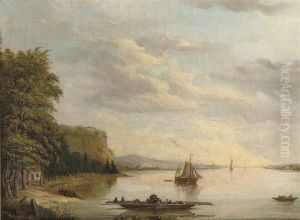Abraham Nicolaas Godefroy Paintings
Abraham Nicolaas Godefroy was a Dutch architect whose work and influence spanned the late 19th and early 20th centuries, a period marked by significant transformations in architectural styles and philosophies. Born in 1862 in the Netherlands, Godefroy was part of an era that witnessed the transition from traditional to more innovative and diverse architectural approaches, including the Art Nouveau movement, which sought to break away from classical conventions and embrace more organic, decorative, and functional designs.
Godefroy's architectural style was characterized by a keen attention to detail, a strong sense of proportion, and a preference for combining both traditional and modern elements. Throughout his career, he contributed to the design and construction of numerous buildings, ranging from residential homes to public and institutional structures. His work was influenced by the broader movements of his time, including the Arts and Crafts movement, which emphasized the importance of craftsmanship and the beauty of natural materials, and the later Art Deco movement, known for its bold geometric forms and decorative motifs.
Not only was Godefroy a practicing architect, but he also played a significant role in the architectural community of the Netherlands, contributing to the professional discourse through writings, lectures, and participation in architectural societies. His legacy includes not only the buildings he designed but also his influence on a generation of Dutch architects who followed in his footsteps, pushing the boundaries of architectural practice and thought.
Godefroy's work remains an important part of the architectural heritage of the Netherlands, reflecting the evolving tastes and technologies of his time. He passed away in 1944, leaving behind a body of work that continues to be studied and appreciated for its contribution to the development of modern Dutch architecture. His career is a testament to the dynamic and ever-changing nature of architecture, embodying the transition from the historicism of the 19th century to the more eclectic and experimental approaches of the 20th century.
